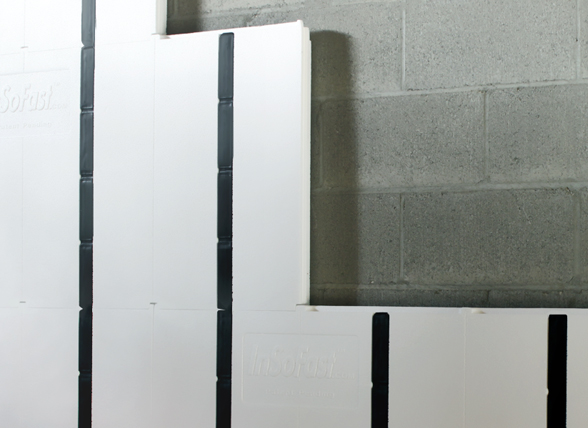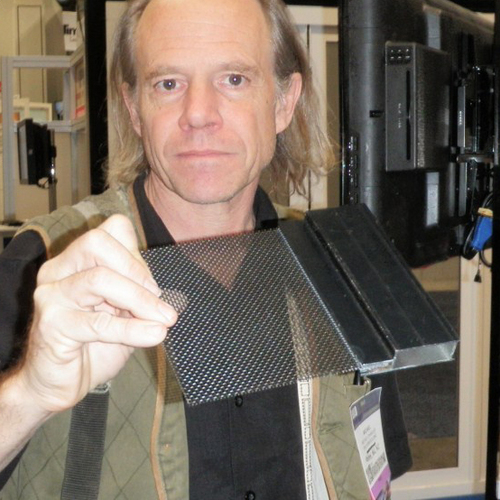
Image Credit: InSoFast
Here’s my latest round-up of cool products from the International Builders’ Show in Las Vegas.
InSoFast polystyrene panels
A Minnesota company, InSoFast, is selling 2-in.-thick expanded polystyrene panels for finishing the interior of basement walls. The panels have several good design features, including vertical drainage channels on the back side, vertical polypropylene strips that accept screws when attaching drywall, and integrated wiring chases.
Drain Plane plastic furring strips
Another Minnesota company, Drain Plane, has come out with a new plastic furring strip for rainscreen walls. The 3/8-in. by 1 1/2 in. battens include notches to allow free drainage and ventilation when installed vertically or horizontally. Drain Plane battens come in 6 ft. lengths; a box of 150 battens costs $500.
The Doorbrow keeps rain off your door
The Doorbrow is a simple plastic canopy for protecting exterior doors from the weather. It can be integrated with almost any type of siding.
The Doorbrow has been criticized for its plain-Jane looks, but the device is practical. The brow is 44 in. wide and projects 6 1/2 in. from the wall plane. Although it may appear to provide scant protection, I’m sure such a canopy would add years of life to an otherwise unprotected exterior door. Retailing for $89, the Doorbrow is a bargain.
Quickflash for refrigerant lines
Quickflash (www.quickflashproducts.com), the company that pioneered “roof boots for wall penetrations,” is selling a very useful plastic flashing panel that creates a watertight method of installing refrigerant line penetrations in exterior walls. If the siding guys remember to install the flashing panel (A/C 150), then the HVAC installer will have an easy way of running a copper refrigerant line.
GreenSwitch
A Texas company is selling the GreenSwitch (www.greenswitchteam.com), a switch intended for the interior side of the main exterior door of a home. The switch controls operation of…
Weekly Newsletter
Get building science and energy efficiency advice, plus special offers, in your inbox.

This article is only available to GBA Prime Members
Sign up for a free trial and get instant access to this article as well as GBA’s complete library of premium articles and construction details.
Start Free TrialAlready a member? Log in














8 Comments
I don't get it
Martin - I have to disagree with you on the Doorbrow. I blogged about it a while ago when I first ran across it.
(http://www.greenbuildingcurmudgeon.com/2008/12/am-i-hallucinating-or-what.html)
In addition to being profoundly ugly, in most cases, including the applications shown on their website, it will create more problems than it solves. They demonstrate it being nailed directly to the face of the stucco, relying on caulk to keep water from running down behind it and through the nail holes. If you install it correctly, before the wall finish is installed, you may as well design the building right to keep moisture off the door in the first place. You can do it wrong very cheaply or do it right for a few dollars more and as a bonus it won't look stupid.
Surface-mounted? Ugly?
Carl,
Thanks for alerting me to your previous blog posting. I agree with you completely that surface-mounting this product would be crazy. It goes without saying that any wall flashing must be installed correctly, with proper attention to the weather-lapping of each layer, beginning with the WRB.
Concerning aesthetics, here's my opinion: There's nothing uglier than an unprotected exterior door (which, by the way, I see all the time). I know from observation and experience that this product would make a significant difference compared to no door protection at all. Better yet would be a well-designed gable roof, properly supported and flashed to the wall. But for $89, this product will find a market, and will result in weather protection for doors that would otherwise be exposed. It's a step in the right direction, in my opinion.
So long as we're being picky...
I hesitate to dive in here but when I first looked at the Drain-Plane extruded plastic product I had to shake my head.
I make rain screen battens by ripping up waste 1/2" OSB into 2-3" strips. I'm paying around $7 a sheet for the stuff so even if I had to buy all the it all new rather than divert it from the landfill I can rip the equivalent of 150 six foot battens out of seven sheets at a cost of $49, one tenth the cost and much more convenient to get to the job site.
I don't think I have so much water penetrating my siding that I need to worry about notching the back of the battens to allow the drips to run down the house wrap. And I think the drying potential of the siding is enough to compensate for the lack of air flow. (Y'all can jump on me here.)
Of course I also believe in overhangs, we generally run 32" tails with 5" gutters so we have more than three feet of protection on our homes and the only rain our walls see is occasional wind-driven rain and splash back from roofs and landscape. So that amps up the drying potential somewhat.
As I said, I hate to be picky but, since Carl started it, I felt like I might as well chime in.
It's still ugly
Martin - Glad that you realized they were showing it reverse flashed on their website. That alone should be grounds for torture or execution. But if you need to protect the door during new construction or a big enough renovation that you are stripping siding to get behind the rainscreen, why not just do something that isn't ugly from the start?
Problems With OSB Furring
Good Morning everyone, as the manufacturer of Drain-Plane, I would like to respond to the comments made in regards to using OSB furring strips. I would like to do so by using the comments from a contractor using my product, written in response to a similar suggestion months ago by another skeptic.
"Although a lot of us enjoy an opportunity to save some money on a project when we can, there are those of us who make a nice living as restoration contractors cleaning up the work of those who like to "Save a few bucks". The proper way to perform this task is to use treated lumber (more pricey), which requires the use of stainless nails for the strips, and then once again to apply the cladding (really pricey). There is also the element of time consumption involved in cutting your own strips. This option may still be somewhat more affordable than some of the manufactured products, and I will state that this is a practice used in several areas where furring strips are required or recommended. However, I would suggest at least looking into the possibility of a superior method, such as a product manufactured from recycled plastic. However again, as I stated previously I am an Associate of a firm that makes its money in repair and restoration, so I do not want to completely discourage the practice of cutting corners and saving a buck on the part of others."
I enjoyed this response and hope that you may also get a little knowledge and entertainment from it. I would also like to add that, the use of a flat wood product installed against the house wrap at the stud location can create the potential for moisture entrapment a this location, which could be transferred back into the sheathing and stud causing potential damage over time. The ventilated furring strips or alternative manufactured products would alleviate the potential of this occurring. In addition, most of your manufactured products will carry a warranty for materials and labor, which I do not think ripped OSB will. I really think it comes down to cost versus peace of mind and “Best Practices”.
Response to OSB Furring Strips
Good Morning everyone, as restoration contractor with 15 years experience installing windows and siding and now the manufacturer of Drain-Plane, I would like to respond to the comments made in regards to using OSB furring strips. I would like to do so by using the comments from a contractor using my product, written in response to a similar suggestion months ago by another skeptic.
"Although a lot of us enjoy an opportunity to save some money on a project when we can, there are those of us who make a nice living as restoration contractors cleaning up the work of those who like to "Save a few bucks". OSB is not an appropriate material to use in this application. OSB would need to be protected from any bulk water that could make it past siding. We all have seen what can happen to OSB when it is repeatedly exposed to water. If you choose to use wood as the furring strip you would want to use the proper way to perform this task is to use treated lumber (more pricey), which requires the use of stainless nails for the strips, and then once again to apply the cladding (really pricey). There is also the element of time consumption involved in cutting your own strips. This option may still be somewhat more affordable than some of the manufactured products, and I will state that this is a practice used in several areas where furring strips are required or recommended. However, I would suggest at least looking into the possibility of a superior method, such as a product manufactured from recycled plastic. However again, as I stated previously I am an Associate of a firm that makes its money in repair and restoration, so I do not want to completely discourage the practice of cutting corners and saving a buck on the part of others."
I enjoyed this response and hope that you may also get a little knowledge and entertainment from it. I would also like to add that, the use of a flat wood product installed against the house wrap at the stud location can create the potential for moisture entrapment a this location, which could be transferred back into the sheathing and stud causing potential damage over time. The ventilated furring strips or alternative manufactured products would alleviate the potential of this occurring. In addition, most of your manufactured products will carry a warranty for materials and labor, which I do not think ripped OSB will. Drain Plane is a 100% recycled product that will remain stable if it gets wet and will allow drainage and drying behind the strip. It’s a quick and easy to install and can give builders additional peace of mind knowing that any moisture that gets in has a better chance at getting out.
I really think it comes down to cost versus peace of mind and “Best Practices”.
Thank you
Thank you to GBA For mentioning Drain-Plane!
OSB Furring Strips
This is more of a question than a comment...
If using OSB furring strips as your drainage plane, should you at least prime them with paint or sealant before installing them?
Log in or become a member to post a comment.
Sign up Log in